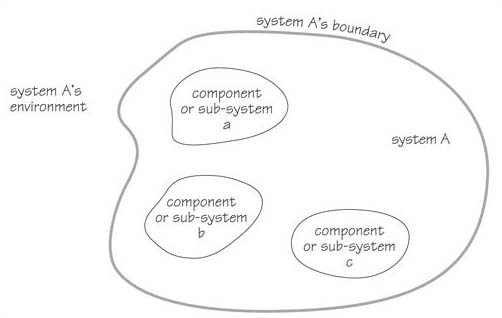4 Why do systems thinkers use diagrams?
Systems thinking and concept
Much can be said about systems thinking. However it is worth reiterating some key points here as they are central to understanding the purpose of the diagrams discussed later in this section.
The word system is one that is in regular everyday use. People talk, for example, about ‘the social security system’ and the ‘telephone system’. Gamblers boast about ‘having a system’ for winning at roulette. Young people talk about being ‘against the system’.
The trouble with everyday speech is that it is often imprecise. People mean different things by the same word. When a gambler speaks of having an infallible system for winning, for example, he is using the term in a different sense from an engineer who works on the telephone system. Since the concept of system is absolutely central to using systems thinking, we cannot afford the potential confusion that this might cause.
The definition of a system that I most use has four parts:
-
A system is an assembly of components connected together in an organised way.
-
The components are affected by being in the system and are changed if they leave it.
-
The assembly of components does something.
-
The assembly has been identified by someone as being of interest.
These all seem straightforward enough, but they each have important implications. Let's examine them in turn.
-
A system is an assembly of components connected together in an organised way.
The stress here is on the word ‘organised’. This means, for example, that the components of a clock piled together in a heap on a table awaiting assembly do not constitute a system. After assembly, however, they do make up a system because their interconnections have been organised.
-
The components are affected by being in the system and are changed if they leave it.
As an example, think of the physiological system that is your body. Its components are organs such as your heart, liver, kidneys and lungs. Clearly they are changed if they are removed from the system: they decay, they become inert and lifeless.
So far, so good. But actually this part of the definition has very far-reaching implications. For if the components are different in some way when they're in the system from when they're not, then the system as a whole must have properties deriving from the interactions of the components that cannot be deduced or predicted from an inspection of its components taken in isolation. One common way of putting this is to say ‘the whole (i.e. the system) is greater than the sum of its parts’.
-
The assembly of components does something.
This part of the definition covers two aspects. First, systems are dynamic entities. Second, and even more important, that a system behaves as if it has some purpose.
Thus to return to an earlier example, it is inadequate to talk about the telephone system as if it were just a thing that everybody instantly recognises and fully understands in the same way as, say a pencil (this passive use of the word system as a noun is the most common everyday use). Rather, we need to talk about a ‘system for employing engineers’ or a ‘system for enabling friends and family to chat to each other’ or ‘a system to give investment returns to shareholders of the telephone company’ – a construction which uses active verbs to highlight its dynamism and purpose and so make it more specific and identifiable.
-
The assembly has been identified by someone as being of interest.
This is important because it brings out the fact that a system is essentially a private, personal idea: a construct. A system can be (and often is) simply a personal ordering of reality, the result of seeing some degree of orderly interconnectedness in some part of the world. Thus a system, any system, can be many different kinds of system simultaneously, depending on who is studying it and why, as shown immediately above. In some cases we might agree on the purpose of the system, in other cases we may have to deduce a purpose for the chosen system.
My definition of a system is incomplete, however, without considering two other, related, terms: environment and boundary.
The reason for this is that you can only define a system by ‘drawing’ a boundary that distinguishes those bits of what you ‘observe’ from everything else, i.e. the system's environment (see Figure 10). Hence you cannot think of a system without thinking of its boundary and what is outside the boundary (its environment).

The concept of environment might seem reassuringly familiar to you: it's a term in daily use – such as when people talk about ‘pollution of the environment’. But the everyday interpretation of the term, which usually amounts to ‘everything out there’, is too fuzzy, too imprecise to be useful. So we adopt a more restricted interpretation:
The environment of a system is made up of those things that are not part of the system, but can affect the system.
The concept of a system boundary follows naturally from that of environment. It is simply a notional line that divides a system from its environment. This means that a boundary is a subjective idea. A system boundary doesn't have to correspond to any real-life barrier or the limits of an organisation for instance.
Choosing where to draw a system's boundary therefore requires you to exercise some judgement. It also depends very much on your reasons for examining the system. Thus, if you're interested only in the reason why a particular component in your car has failed, it may be appropriate simply to draw the boundary round the engine or a particular sub-system of parts (e.g. the electrical system). But if you are a government safety official investigating why a particular component tends to fail in a certain make of car, you may have to widen the boundary to include the dealer-network for the marque in question, the factories that manufacture the model, suppliers, subcontractors, trade unions, etc. Knowing where to draw the boundary is one of the fine arts of systems practice. Where you choose to draw it can often say a great deal, not just about your views, but also about your values.
